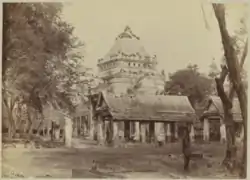Sommot Amon Mak Bridge
Sommot Amon Mak Bridge (Thai: สะพานสมมตอมรมารค, RTGS: Saphan Sommot Amon Mak, pronounced [sā.pʰāːn sǒm.mót ʔā.mɔ̄ːn mâːk]) is a historic bridge over the khlong (canal) in Bangkok. It's located on Bamrung Mueang road between Phra Nakhon district's Samran Rat sub-district and Pom Prap Sattru Phai district's Ban Bat sub-district.
Sommot Amon Mak Bridge สะพานสมมตอมรมารค | |
|---|---|
_-_img_01.jpg.webp) | |
| Coordinates | 13°45′7.96″N 100°30′18.78″E |
| Carries | Bamrung Mueang Road |
| Crosses | Khlong Bang Lamphu |
| Locale | Samran Rat Sub-District, Phra Nakhon District and Ban Bat Sub-district, Pom Prap Sattru Phai, Bangkok, Thailand |
| Official name | Sommot Amon Mak Bridge |
| Other name(s) | Saphan Lek Pratu Phi (Iron Bridge at Ghost Gate) |
| Maintained by | Bangkok Metropolitan Administration (BMA) |
| Characteristics | |
| Design | Ionic |
| Location | |
The bridge that can be considered as another Saphan Lek (สะพานเหล็ก; lit: iron bridge) of Bangkok alike Damrong Sathit and Phitthaya Sathian bridges. Since it was originally a steel structure and could be removed for boat pass through. So it was named "Saphan Lek Pratu Phi", because the area it's located is called "Pratu Phi" (ประตูผี; ghost gate). This area in the early Rattanakosin period there's gate for transport dead bodies from the inner city or within Grand Palace. Because this area is located in the west, it's believed that the direction of the dead.[1]
Later, in the reign of King Chulalongkorn (Rama V). The bridge has deteriorated, he ordered the Department of Public Works to restore the bridge as a concrete bridge in today, includes was officially named "Sommot Amon Mak" (literally translates as "way of who assume as immortal", that refers to "way of deity", meaning "way of divine king") in honour of Prince Sawasdiprawat.

The striking feature is that the banisters are Ionic architecture. It has been registered as one of the ancient monuments of Bangkok.[2][3] At the end of the bridge in Pom Prap Sattru Phai side is an intersection called "Men Pun Intersection", that refers to "cement crematorium intersection". It's an area close to Wat Saket. During the reigns of King Phutthaloetla Naphalai (Rama II) and King Nangklao (Rama III), there was severe epidemics of cholera in Bangkok. There're a lot of dead people and can't be cremated immediately. Many bodies have been left along the road or the temple grounds, so that the vultures are eaten, it's an abomination to those who have seen. The temple that was cremated during that time was Wat Sa Ket, including crematorium made of cement nearby. Presently, the cement crematorium has been demolished but its name still stands today and becomes the official intersection.[1][4]
References
- Line กนก (2016-07-16). "แร้งวัดสระเกศ เปรตวัดสุทัศน์". Nation TV (in Thai).
- "สะพานสมมตอมรมารค (The Sommot Anaramarks Bridge)". Rattanakosin Island Information Center (in Thai).
- "รายงานการศึกษาโบราณสถานที่ขึ้นทะเบียนในกรุงเทพมหานคร ปี พ.ศ.๒๕๕๔" (PDF). BMA (in Thai).
- จินตนะดิลกกุล, สิริลักษณ์ (2002-06-25). "เมรุปูน". Sanook.com (in Thai).